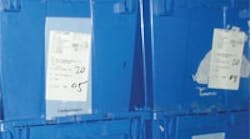Cardinal Health (Dublin, Ohio) is dedicated to improving the safety and productivity of healthcare. It is constantly focused on finding new ways to improve the efficiency with which it delivers products and services to customers—many of which are hospitals and pharmacies.
Part of that focus includes lean Six Sigma initiatives, particularly in its distribution centers. Through these initiatives, employees from all levels of the organization gather to identify process improvements that can save both time and money.
Cardinal Health initiated a lean Six Sigma project to determine how it could improve the time and cost efficiency of cleaning returnable delivery totes. The company uses tens of thousands of totes to ship medical-surgical supplies on a just-in-time basis to hospitals nationwide. The project also sought to identify a more consistent, standardized process to ensure totes were clearly identifiable to customers.
Cardinal Health identified several opportunities to improve efficiency. Research found that one of the larger labor components in cleaning totes was the removal of old shipping labels.
Previously, labels were placed on the tote and sent back to the distributor. In each phase of the trip, new labels were applied on top of old. This caused issues with identification, appearance and cost to wash and clean totes.
After researching various products, the Kennedy Group’s (Cleveland) placard identification system was chosen to address these issues. The placard identification system allows repetitive labeling of totes, containers and racks without label and adhesive build up. It provides a vehicle for barcoding and prevents the loss of hang tags, plastic shipping envelopes and other less-secure methods of identification.
Each placard is affixed with pressure-sensitive adhesive to the tote, acting as a permanent label holder. A variable information label, identifying the contents of the container, is placed on the placard. When the contents in the container change, the label can be removed and a label identifying the new contents adhered.
The placards are designed to adhere to a variety of container materials and can accommodate specific properties, such as indoor and outdoor durability, a broad range of surface temperatures, pressure washing and various surface applications.
Initially, the placard presented some challenges. The placard was a standard size but too small for the company’s information label. As a result, labels were placed on various areas of the tote instead of on the placard.
After re-evaluating the application, the Kennedy Group recommended increasing the size of the placard and including the distributor’s name and the phrase “Place Label Here.” This solution has eliminated the need to wash the tote and ensures that it is returned to the distributor. It also increased the probability of the label being placed properly. By implementing this solution in several of its distribution facilities, Cardinal Health has identified approximately $10,000 per month in reduced labor associated with tote cleaning.



